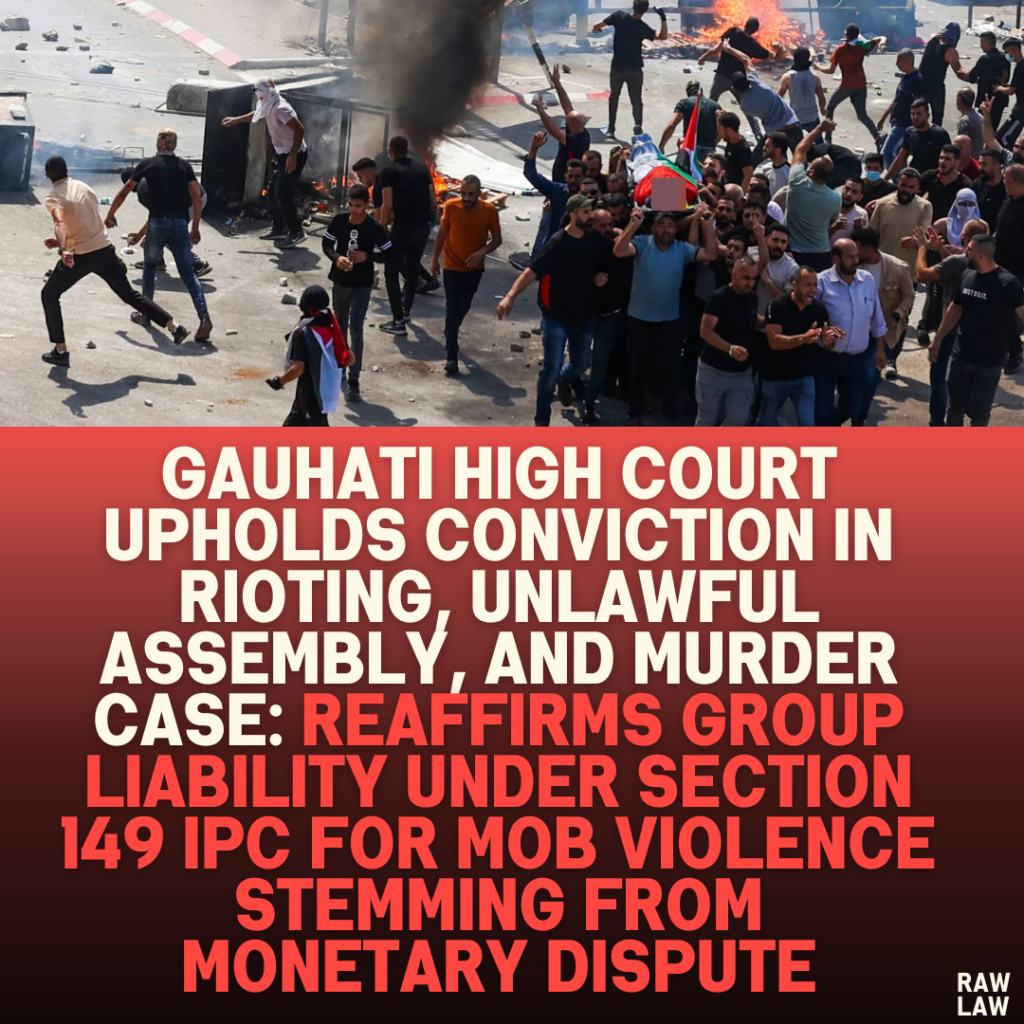Court’s Decision:
- The Gauhati High Court upheld the convictions under multiple sections of the IPC, particularly those related to rioting, unlawful assembly, murder, and arson.
- The accused were sentenced to rigorous imprisonment (RI) for different durations:
- Life imprisonment for murder (Section 302 IPC).
- Six months to two years for rioting, causing injuries, and arson.
- The sentences were ordered to run concurrently (not separately).
- The court rejected the appeal, affirming that the accused were part of an unlawful assembly that committed violent acts.
Facts:
- The case dates back to August 28, 1996, when a group of 45 armed individuals attacked a community at night.
- They used bows, arrows, and guns to attack the residents, burned houses, and caused fatal injuries to three individuals, one of whom later died.
- The motive for the attack was a monetary dispute between the two groups.
- The police investigation resulted in 18 persons being charged, but five absconded, so the trial proceeded against 13 accused.
Issues:
The case revolved around four key legal questions:
- Was the conviction under Section 149 IPC justified? (Did all accused share a common objective?)
- Were the inconsistencies in witness statements enough to weaken the case?
- Did the prosecution successfully establish the identity of all the accused?
- Was the sentence proportionate to the crime?
Petitioner’s Arguments (Defense’s Standpoint):
- The identification of the accused was questionable as some names were missing from the FIR.
- Witnesses gave conflicting statements on who did what, creating doubt about individual responsibility.
- The conviction under Section 149 IPC was challenged, as there was no direct proof that all accused shared a common intent.
- The defense cited Supreme Court precedents, arguing that Section 149 requires strict proof that all accused acted together.
Respondent’s Arguments (Prosecution’s Standpoint):
- Multiple eyewitnesses identified the accused and confirmed their involvement.
- The common object (revenge for monetary disputes) was evident because the accused had armed themselves before the attack.
- The defense’s claim of inconsistencies in witness statements was dismissed as natural variations in human memory.
- The prosecution cited Supreme Court cases affirming that all members of an unlawful assembly are responsible, even if only a few actively participated in violent acts.
Analysis of the Law:
The court analyzed Section 149 IPC, which states:
If an offense is committed by any member of an unlawful assembly in prosecution of a common object, every member of that assembly is guilty of the offense.
- The court ruled that individual acts do not have to be proven—being part of the unlawful assembly was enough.
- Even if some accused did not directly attack the victims, they were legally liable because they were present and part of the group.
Precedent Analysis:
The court cited several Supreme Court rulings to justify its decision:
- Ramchandran v. State of Kerala (2011) – Confirmed that a common object can be inferred from how a group behaves.
- Ramesh v. State of Haryana (2010) – Ruled that specific acts are not needed for conviction under Section 149.
- Surendra Singh v. State of Rajasthan (2023) – Clarified that unidentified individuals in a group do not affect the conviction of others.
- Mohan Singh v. State of Punjab (1963) – Confirmed that not all members need to be present in court to prove an unlawful assembly.
Court’s Reasoning:
- Identification was not disputed. Multiple witnesses confirmed seeing the accused under the full moon.
- Motive was clear. The attack was linked to a previous monetary dispute between the two groups.
- Being part of the mob was enough for conviction under Section 149 IPC.
- Minor inconsistencies in witness statements were not enough to overturn the conviction.
Conclusion:
- The court upheld the conviction under Section 149 IPC.
- It ruled that the prosecution successfully established the accused’s involvement.
- The appeal was dismissed, and the sentences were confirmed.
Implications of the Judgment:
- Strengthened Use of Section 149 IPC:
- The ruling reaffirms that individual participation is not necessary; being part of a violent mob is enough.
- Precedent for Future Cases:
- Future cases involving mob violence and collective crime can refer to this judgment for strict application of group liability laws.
- Significance of Motive:
- The case emphasizes how monetary disputes and social tensions can escalate into serious crimes.
- Reinforcement of Eyewitness Testimonies:
- The court ruled that minor inconsistencies in eyewitness accounts do not automatically weaken a case.
- Legal Framework in Assam:
- This ruling sets a strict precedent for handling communal violence and unlawful assemblies in the state.
